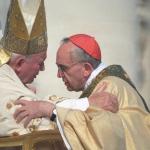Periodically, this odd little tidbit from Matthew comes up in atheist polemics.
At that moment the curtain of the temple was torn in two from top to bottom. The earth shook, the rocks split and the tombs broke open. The bodies of many holy people who had died were raised to life. They came out of the tombs after Jesus’ resurrection and went into the holy city and appeared to many people.
It’s odd for a couple of reasons. First, of course, because Matthew alone notes it; second, because, as Godless in Dixie points out, it raises questions about why the story goes unnoted elsewhere (questions to which GiD is certain he knows the answer); third, it makes you wonder why Matthew bothers to mention it at all, and; fourth, it is a weirdly chronologically jumbled sentence.
FWIW, here is a piece I wrote some time back for the Register dealing with the three out of four of these questions. The fourth question, about the jumbly syntax of passage is, I think, best answered by the fact that Matthew is writing with some excitement, like people do when they are spilling out a story and trying to wedge in everything in a hurry. I doubt he means the OT saints were raised from the dead at 3:00 on Friday and then hung around in their tombs till Sunday morning, killing time and cooling their heels till the resurrection of Jesus. I think he’s just tumbling out the general account of the Jerusalem community (naturally most important to his Jewish audience) that the down payment on the general resurrection at the end of time has occurred and Isaiah has been fulfilled. As to the rest, here’s the piece I wrote some time back:
One of the things that periodically comes up in discussions of the Resurrection is summarized by Christopher Hitchens when he notes that Matthew tells us:
“the graves were opened; and many bodies of the saints which slept arose, and came out of the graves after his resurrection, and went into the holy city, and appeared unto many.” These rather conspicuous events, which among other things would seem to make resurrection something of a commonplace, were entirely missed by Saint John, or at any rate unreported by him, and appear not at all in the only written historical record, which was by Flavius Josephus.
Not only does St. John not report it, but there is in fact a lot unreported by St. John (because he knows the other three gospels have been circulating for quite some time and is not interested in re-reporting their information but in giving his own account for other purposes). There is also, by the way, lots of stuff only reported by St. John (such as the resurrection of Lazarus). This is only mysterious if we don’t pay any attention to St. John, who tells us “Now Jesus did many other signs in the presence of the disciples, which are not written in this book; but these are written that you may believe that Jesus is the Christ, the Son of God, and that believing you may have life in his name.” (John 20:30-31). As to why Josephus and other sources do not report it, thereby hangs an interesting tale.
One of the things that often comes up in anti-theist apologetics such as Hitchens practiced is the fiction that if only God would work some unmistakable public miracle, then belief must naturally follow. But the testimony of the tradition–and by some unfathomable coincidence, all human experience–demonstrates that this is not so. In reality, without the gift of faith and the willingness to receive it, even extraordinary signs can be and are regularly dismissed, “explained” or ignored and make no impression outside the community that accepts them. Emile Zola famously said that he only wanted to see a cut finger dipped in Lourdes water and be healed. When he actually went to Lourdes and was presented with a woman inexplicably healed of tuberculosis before his very eyes, his response was to hold a press conference and declare “Even if I were to see all the sick at Lourdes healed, I would not believe.”
In this he was a kindred spirit with one Christopher Hitchens who responded to claims of the miraculous by condemning pilgrimages. Far from “following the facts wherever they lead”, it is atheists like Hitchens who simply refuse to look while Christians, who are allegedly obscurantists who fear the light of the investigative intellect come and see as Jesus said to do (John 1:39).
So about that strange resurrection in Matthew. Why would it not be reported elsewhere? Well, why are the healings at Lourdes or the Miracle of the Sun not front page news and the subject of countless investigative reports? Why did not Christopher Hitchens not spend his life trying to find out if they happened? Answer: because his heart, mind, and soul had no room to so much as consider taking them seriously.
Many people have a provincial notion that a supernatural event such as Matthew records would have been front page news in the April 9, 33 edition of the Jerusalem Post and would have been carried by newswire to Rome to be duly archived there for modern historians to read about. But, in fact, other (very well documented) supernatural events have occurred, sometimes before tens of thousands of eyewitnesses (the Fatima Miracle of the Sun and Zeitoun are two specimens) and yet outside of a small geographical area, nobody much noticed. Even today, you can find copious evidence of startling supernatural occurrences (video of a Bleeding Host at Betania, for instance) or phenomena such as the healing of a nun from Parkinson’s after prayer to JPII. The world is, in fact, chockablock with testimonies to such curious events and they take place under our noses all the time. But if you have a doctrine against them, there’s no particular reason you will accept that they happened without the gift of faith. So the Miracle of the Sun, witnessed by 70,000 people, made a small splash in the local Portuguese secular press and almost no impression anywhere else. Likewise, even today, be honest: do dismissers of the miraculous really spend any time poring over the findings of the Medical Bureau at Lourdes or boning up on the Eucharistic Miracle at Lanciano? Of course not. They have a dogma that teaches them that such things are silly and a waste of time: the sort of trash ignorant peasants believe. And so, they don’t look and don’t listen and get on with their day.
In the case of the resurrections Matthew reports I see no reason why exactly the same thing would not obtain. We are under no obligation to think the risen saints appeared to everybody in Jerusalem. There is plenty of reason to think the appearances were limited to only the small community of believers (Luke numbers only 120 in the Upper Room at Pentecost, and he is probably only counting men). So double that and you have “many” to whom this portent was granted on Easter morning. And there is no reason why this particular sign would have been noted by the rest of the world any more than the other signs God has done down through history would be noted outside the community of the faithful. This includes, of course, Flavius Josephus, whose passing acquaintance with the Christian movement would give us no more reason to think he would pay anyt more attention to such a story than your passing acquaintance with, say, the Lubavitcher sect of Judaism would cause you to pause and wonder if the Rebbe really has worked miracles. Until you go and look and weigh the evidence, you are simply an average human being, doing what average human beings do and filtering out sensory data you don’t know how to fit into your ordinary interpretive framework. That atheists filter out evidence for miracles due to their dogmatic insistence that they cannot happen is no evidence that they can’t. It’s merely evidence that even if they did, the atheist would not be able to accept it till he repented of his stupid a priori dogma. A Christian is free to accept or reject miracles on the basis of the evidence. As a general rule, the Church winds up rejecting most claims of miracles, either because the evidence is insufficient, or because the claimant is shady, crazy, or mistaken. The notion that Christians are gullible twits who believe any claim of the miraculous is vastly over-rated. But the fact that materialists dogmatists believe in materialism by a dogged act of faith is a fact.
For me, the puzzle is not so much whether this particular event mentioned by Matthew happened but rather why Matthew bothers to note it. Matthew has, after all, demonstrated all the earmarks of an honest witness. He not only records facts damaging to his own case such as his own cowardice (abandoning Jesus) and calls witnesses no dishonest man would ever call (women? in first century Jewish culture?) to attest the Resurrection. He even records sayings of his Hero that no dishonest man would ever record: Jesus asking questions. Jesus declaring that he does not know when the end of the world will come. Jesus crying out “My God! My God! Why have you forsaken me?”
All of this is extremely awkward and best left unsaid if you are a con man trying to sell a lie. But there it all is, because Matthew, like all the evangelists, clearly believes the story he is telling and is stuck giving us what he and his community remember actually occurring. To be sure, he is not trying to write a comprehensive biography. None of the gospels attempt that. They are all essentially Passion narriatives with long introductions, taking an assortment of incidents and sayings from the life of Jesus in order to illustrate the meaning of what Jesus’ passion and resurrection means and what he has accomplished for us. This resurrection incident (recorded by Matthew alone) has that theological purpose like everything else in Matthew’s gospel, but I’m not altogether clear what he is trying to point out. My suspicion is that he sees in this incident a fulfilment of Isaiah 25:7-8:
And he will destroy on this mountain the covering that is cast over all peoples, the veil that is spread over all nations. He will swallow up death for ever, and the Lord GOD will wipe away tears from all faces, and the reproach of his people he will take away from all the earth; for the LORD has spoken.
That’s because Matthew, more than any other evangelist, is concerned with how Jesus is the fulfilment of Old Testament prophecy. So it is essential to his thought that this “little general resurrection” take place, not everywhere, but in “the holy city” of Jerusalem. It is on thismountain–Zion–that death is to be destroyed, according to the prophet. So the promise is kept and this is a sort of down payment for what will come in the resurrection on the Last Day for “all peoples”.















